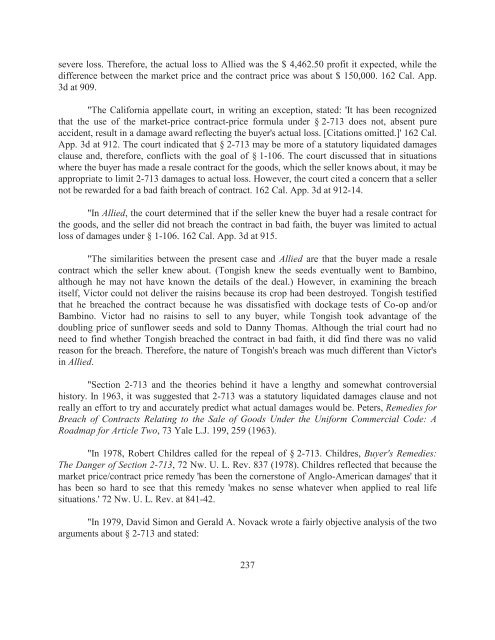Sales and Leases - A Problem-based Approach, 2016a
Sales and Leases - A Problem-based Approach, 2016a
Sales and Leases - A Problem-based Approach, 2016a
Create successful ePaper yourself
Turn your PDF publications into a flip-book with our unique Google optimized e-Paper software.
severe loss. Therefore, the actual loss to Allied was the $ 4,462.50 profit it expected, while the<br />
difference between the market price <strong>and</strong> the contract price was about $ 150,000. 162 Cal. App.<br />
3d at 909.<br />
"The California appellate court, in writing an exception, stated: 'It has been recognized<br />
that the use of the market-price contract-price formula under § 2-713 does not, absent pure<br />
accident, result in a damage award reflecting the buyer's actual loss. [Citations omitted.]' 162 Cal.<br />
App. 3d at 912. The court indicated that § 2-713 may be more of a statutory liquidated damages<br />
clause <strong>and</strong>, therefore, conflicts with the goal of § 1-106. The court discussed that in situations<br />
where the buyer has made a resale contract for the goods, which the seller knows about, it may be<br />
appropriate to limit 2-713 damages to actual loss. However, the court cited a concern that a seller<br />
not be rewarded for a bad faith breach of contract. 162 Cal. App. 3d at 912-14.<br />
"In Allied, the court determined that if the seller knew the buyer had a resale contract for<br />
the goods, <strong>and</strong> the seller did not breach the contract in bad faith, the buyer was limited to actual<br />
loss of damages under § 1-106. 162 Cal. App. 3d at 915.<br />
"The similarities between the present case <strong>and</strong> Allied are that the buyer made a resale<br />
contract which the seller knew about. (Tongish knew the seeds eventually went to Bambino,<br />
although he may not have known the details of the deal.) However, in examining the breach<br />
itself, Victor could not deliver the raisins because its crop had been destroyed. Tongish testified<br />
that he breached the contract because he was dissatisfied with dockage tests of Co-op <strong>and</strong>/or<br />
Bambino. Victor had no raisins to sell to any buyer, while Tongish took advantage of the<br />
doubling price of sunflower seeds <strong>and</strong> sold to Danny Thomas. Although the trial court had no<br />
need to find whether Tongish breached the contract in bad faith, it did find there was no valid<br />
reason for the breach. Therefore, the nature of Tongish's breach was much different than Victor's<br />
in Allied.<br />
"Section 2-713 <strong>and</strong> the theories behind it have a lengthy <strong>and</strong> somewhat controversial<br />
history. In 1963, it was suggested that 2-713 was a statutory liquidated damages clause <strong>and</strong> not<br />
really an effort to try <strong>and</strong> accurately predict what actual damages would be. Peters, Remedies for<br />
Breach of Contracts Relating to the Sale of Goods Under the Uniform Commercial Code: A<br />
Roadmap for Article Two, 73 Yale L.J. 199, 259 (1963).<br />
"In 1978, Robert Childres called for the repeal of § 2-713. Childres, Buyer's Remedies:<br />
The Danger of Section 2-713, 72 Nw. U. L. Rev. 837 (1978). Childres reflected that because the<br />
market price/contract price remedy 'has been the cornerstone of Anglo-American damages' that it<br />
has been so hard to see that this remedy 'makes no sense whatever when applied to real life<br />
situations.' 72 Nw. U. L. Rev. at 841-42.<br />
"In 1979, David Simon <strong>and</strong> Gerald A. Novack wrote a fairly objective analysis of the two<br />
arguments about § 2-713 <strong>and</strong> stated:<br />
237


















